The NYT’s Dual Endorsement
The paper of record endorsed both Warren and Klobuchar
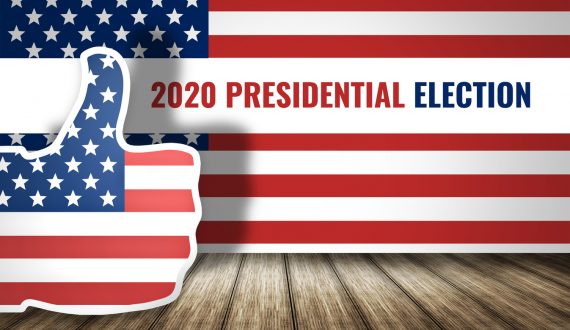
Since last night, Twitter has been, well, all atwitter about the fact that the NYT editorial board decided to endorse both Elizabeth Warren and Amy Klobuchar, Amy Klobuchar and Elizabeth Warren: The Democrats’ Best Choices for President.
First off, missions accomplished. People are talking about the Times. I think this is the first time I have read a newspaper’s endorsement in quite some time.
Second, the essay itself actually makes some legitimate points and highlights some of the deficiencies in our electoral system.
The basic thesis of the piece is that the US is looking at three possible visions for the next four years.
There is first Trump:
The incumbent president, Donald Trump, is clear about where he is guiding the Republican Party — white nativism at home and America First unilateralism abroad, brazen corruption, escalating culture wars, a judiciary stacked with ideologues and the veneration of a mythological past where the hierarchy in American society was defined and unchallenged.
And then there is the division within the Democratic Party:
On the Democratic side, an essential debate is underway between two visions that may define the future of the party and perhaps the nation. Some in the party view President Trump as an aberration and believe that a return to a more sensible America is possible. Then there are those who believe that President Trump was the product of political and economic systems so rotten that they must be replaced.
In other words, there is a more moderate lane (e.g., Klobuchar, Biden, etc.) and a more progressive one (e.g., Warren, Sanders, etc.) for the Democratic nomination. Although, as the piece notes there is a “similarity of their platforms on fundamental issues.” This is not surprising, as they are all working under the umbrella of the Democratic Party nomination process, competing for the same cache of voters.
A lot of the piece is just descriptive, with some arguments about why Warren and not Sanders and why Klobuchar and not Biden.
But, look, the editorial board, after meeting with the candidates, expressed an opinion (as they are wont to do) and I have no problem with the dual endorsement, especially since I rarely give much heed to them in the first place.
This essay struck me because it is yet another example of the way in which our institutions hamstring democracy. The reality is that, in fact, yes there are multiple major strains of political thought in the US at the moment, but our institutions shoehorn us into two pathways.
In simple terms: if we had an electoral system that used either two rounds or an instant run-off, the incentives for party formation would shift radically. This is because under such a scenario, candidates could run in the first round with the goal of not winning a plurality, but of coming in second. Voters could also vote their honest preferences in the first round much more effectively than they can under under a plurality system.
To put it as plainly as possible: politicians only have two viable routes to the presidency. These are the Republican nomination and the Democratic nomination. Likewise, voters only have two viable places to cast their ballots in support of candidates who have any real chance of being president. These are the Republican nominee or the Democratic nominee.
Yes, I am well aware that it is theoretically possible for a third party candidate to win the presidency. But not only is the historic pattern clear, the reality remains that barring a huge disruption in our political order this is way it works. Also, yes, voters can vote for third party candidates as a signalling device or as a pure expression of preference, but that does not take away from the fact that the only votes for candidates (well, actually for slates of electors) that are cast for people who have any reasonable shot at holding office have either a D or an R by their names.
Candidates know this, and so if they want to be president, they have to compete in either the Republican or Democratic nomination process. The permissiveness of those processes allows for the kind of factionalism we see currently in the Democratic field. It is also how an amateur like Donald Trump was able to take over a party.
As I have noted on multiple occasions: Bernie Sanders is running for the Democratic nomination because it is his only realistic pathway to the presidency despite the fact that he has been an independent his entire career and identifies as a “democratic socialist.”
Really, it is not hard to see that the American electorate is divided into at least four categories (of differing sizes, I would note) that would form parties under different electoral parameters:
- Progressives
- Center-left
- Center-right
- Trumpian nationalists
Right now, 1+2 forms the basis of the Democratic electorate and 3+4 make up the GOP electorate. There are no challengers emerging in the #3 category because the presidency is held by #4 (the next time the seat is open, expect a contest between those factions). But there is a vigorous fight currently between 1 and 2.
And yes, there are other possible parties: Greens, Libertarians, and so forth, but I am talking large centers of political gravity around which parties could form under the right circumstances.
The bottom line being that if our system did not straight-jacket competitors, we see more options. And there would be a greater incentive for a more consensus alternative to emerge in a second round (or, at least, a winner who actually had true majority support–such a concept!).
Such a scenario would also allow clearer messaging to the population. We would have, in this alternative reality, a real Warren v. Sanders debate and a Biden v. Klobuchar, etc. debate. We would also have a place for NeverTrumpers to actually compete instead of either drifting to the Democrats or eventually acquiescing to Trumpism.
But, alas, we are stuck with weak parties that have to have very public internal fights to determine a nominee who is increasingly someone who makes a significant segment of the party angry (as James Joyner noted earlier today). Or we get voters and supporters having to tie themselves into pretzels to support their guy because a binary choice plus life-tenure for judges equals a lot of room for rationalization.
All of this is to say that I get why the NYT bifurcated its endorsements and I just wish that our electoral institutions would allow that same luxury to our party system.

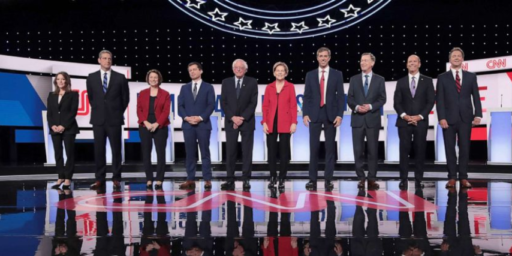
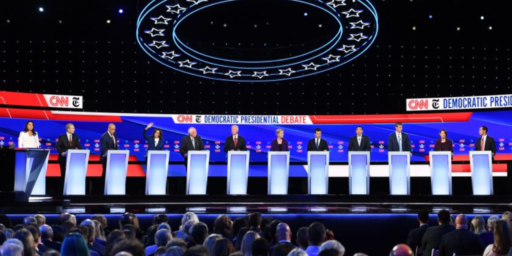
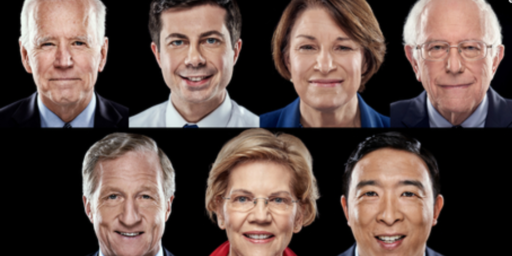
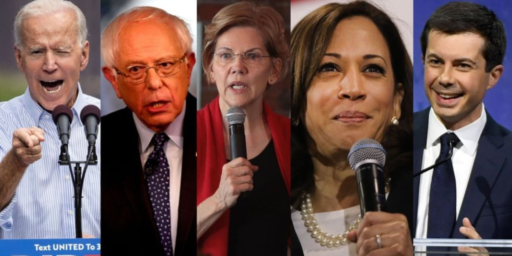
As you note, the editorial had the desired effect of getting people talking about the editorial. But Klobuchar is an odd endorsement. They might as well have come out for Cory Booker or one of the many governors who have already dropped out of the race. She’s equally likely to get the Democratic nomination, after all.
I understand what the NYT board is doing – giving a nod to both progressives and to centrists. But I think they’re making a bigger statement by endorsing two women over male front runners Bernie and Joe.
@James Joyner: But that assumes that the job of the editorial board is to endorse probable winners, as opposed to their assessment of the candidates.
And to al Ameda‘s point, I think this is also about gender (and, to a degree, age).
The NYT piece is an excellent opportunity for you, as a Poli Sci prof to write about the flaws in our electoral system. It’s also an opportunity for NYT to philosophize about the current state of our politics. But I’ll stick with my previously expressed opinion that as a political endorsement it’s pretty shitty.
They should, like everyone else, hold their nose and pick a candidate. And maybe do a little self reflection on their knee jerk reaction to a wealth tax without considering counter-arguments or alternatives. And without considering why Piketty and many others support a wealth tax. (It ain’t just for revenue.) Or that it’s moot if GOPs keep 51 senators and therefore it’s just aspirational campaign rhetoric, not unlike Biden saying he’ll make nice with GOPs.
And, really, I don’t take the endorsement itself as all that significant, save for what it says about political factions within the Democratic Party, etc.
@gVOR08:
I would argue that the NYT editorial page exists to philosophize and that its actual power to influence the race is quite small. (Remember how all the papers endorsed Hillary, even the conservative ones?).
@Steven L. Taylor: If newspaper endorsements ever mattered, they don’t now. But, to the extent they’re of any value, they should deal in the realm of plausibility.
It’s one thing for a blogger, or even a columnist, to say “I know Klobuchar is way behind in the polls but, doggone it, she’d be a way better President than any of the frontrunners.” But it’s just weird for an editorial board to do that.
@James Joyner: I would counter that if the board is supposed to only endorse people whom the polls show as having a chance to win, then just base the endorsement off the polling and forgo the interviews.
I take your basic point in any event.
In 1980 The New Republic endorsed John Anderson. I voted for him too!
In the 80’s TNR was a little hard to pin down
Maybe the NYT Editorial Board is on the same page as me…I don’t care who you nominate.
I’d vote for a homeless guy chosen at random, from the local shelter, before I would ever vote for Trump.
I don’t really have any opinion on the NYT endorsement(s) except that it seems very calculated.
I don’t know of any reason why the two parties couldn’t adopt this model except the willingness to do so. Moving to this for primaries would be an interesting test case that would show how this system would work in practice and perhaps convince enough Americans that it might be a better alternative for the general election. And I do think it would make primaries a lot better in terms of nominating the best candidate and determining party member preferences.
@Andy: I am referring there to using that mechanism for electing the president, not for nominating candidates.
I wonder how much the impossibility of a third-party candidate to win is a self-fulfilling prophecy.
Oh, I know there have always been two parties, though the parties have changed (no one votes Whig anymore).
The parties kind of had a looser hold on candidates, too, even as they had a more central role in the nomination. Look at the 1860 election, which Lincoln won, and it seems to have taken place in some kind of parallel universe rather than our own.
Or this just confirms this quote by L.P. Hartly “The past is a foreign country, they do things differently there.”
@Kathy: The 1860 election is, as best I can tell, sui generis—and led to a civil war in which 600,000-plus Americans were killed. A new party, the Republicans, had arisen the previous cycle as another, the Whigs, were dying. And the Democrats split into northern and southern factions.
Lincoln won the Electoral College despite four major candidates in the race and getting under 40 percent of the vote. But the key was that the large states were concentrated in the Northeast and Midwest and Lincoln carried almost all of them.
@Kathy:
Probably the only way a viable 3rd party develops is if the GOP continues off the rails toward National Conservatism and white identity politics while the Dems go off in the direction of the UK Labor Party or French Socialists. It is barely possible that the never-Trumpers, main street and suburban republicans could attract enough center-left Dems to build a competitive party. It won’t happen though.
@Steven L. Taylor:
Yes, I understood that. I was suggesting that using it for nominations could be a good test case for political and practical reasons.
@James Joyner:
Oh, yes. absolutely. But it shows that two candidates could run on the same party (sort of). Imagine that today.
That kind of seems to be the case in US politics: for a new party to rise, an older party must die. At least as far as contending for the presidency goes. Independents now and then may win a House or Senate election, but then they have to align with one of the major parties or be shut out of all committees. Less frequently, one might win a governorship.
The two current parties have hung on for a long time. Can either of them die? I can see the GOP die of stubbornness, as it keeps shutting out an ever growing part of the population.
@James Joyner:
Which was a little bit deceiving. Lincoln wasn’t even on the ballot in some southern states.
The problem is just that…that these two political parties have such a stranglehold…tying in directly to the post about the WP candidate quiz, it would be better if there were more than just two political polarities in this country…
@An Interested Party:
But with both parties having such a stranglehold, it would be insanely difficult for a new party to make any significant gains.
I think this is a Catch-22
In regards to a number of comments above about the probabilities of a third party: I cannot stress enough that the primary process makes substantial new party formations (a la Whigs and Reps, for example) all but impossible. The cost and benefit of winning the D or R nomination is radically lower and radically higher (respectively) than then cost/benefit of starting a new party from scratch.
Steyer and Bloomberg both are smart to at least avoid Perot’s mistake.
I thought I had beat this to death, but maybe I need to write some more…
I wish this were true, but I fear it is not. If it were true, the block of center-right voters could be swayed by logic and pragmatism to reject the lunacy of block #4.
What I think we actually have (in numbers large enough to matter) are:
1. Outright communists and socialists
2. Progressives
3. Centrist liberals
4. Centrist conservatives
5. Single-issue voters (e.g. abortion, gun rights, immigration, Christian theocracy)
6. Protectors of wealth (in addition to those in group 5)
7. Nativists, presently united behind Trump (in addition to those in groups 5 and 6)
While block 4 might be persuadable, blocks 5 and 6 are not, and I suspect that they are collectively larger than block 4, and group 6 is influential beyond its size.
@Sleeping Dog:
There’s a classic Simpsons Halloween ep where the two aliens, Kang and Kodos, supplant Clinton and Dole (wow, that was a along time ago!), in order that one of them will be elected president.
When Homer unmasks them (after he kills the real Clinton and Dole accidentally), Kang admits the’re aliens, and asks “But what are you going to do about it? It’s a two-party system.” Someone suggests voting for a third-party candidate, to which Kodos mocks “Go ahead. Throw your vote away.”
So one gets elected and enslaves all humans.
In some ways, 2016 was the perfect year for a third party to score big time. after all, both major party candidates had big negatives, and many in their own party couldn’t stand them. Alas, 1) there was no big third party candidate generating any sort of enthusiasm a la Ross Perot, and 2) while many in each party disliked their own candidate, they disliked the other party’s candidate more.
It is reasonable to suppose if both parties again nominate people with large negatives who are disliked inside their own party, and a third party candidate generates a great deal of enthusiasm, this might break the two-party hold.
This depends partly on partisanship. Maybe the Democratic voter hates their candidate, but they hate the GOP candidate even more. Voting for the Independent is appealing, they seem like they’d make a great president, but that’s throwing one’s vote away. So they end up voting for the Democrat they can barely stomach. Flip the parties as needed. Better our SOB than their SOB, right?
@DrDaveT:
While I will readily allow that the categories could use refinement, I am going to state that you are radically underscoring the weigh of institutions and how they filter us into two choices.
And the bottom line remains: if you are prolife and pro tax cut and in block number 3, you are very likely to stick with Trump given, especially, the fact that your only other option is someone who is prochoice and likely in favor of tax increases.
@Kathy:
And yet, still, in most ways not.
I don’t like this fact, but I think it is a rock solid one that we all need to come to grips with. The incentives are quite powerful for just the two.
(I could be a smart ass and state that a third party candidate did win in 2016-but he did so by taking over an existing party. To a point, I actually would argue this is an accurate depiction of what happened).
@Steven L. Taylor:
I think what I was trying to say, in part, is that if you are anti-abortion and/or anti-tax to a degree that prevents being appalled by Trumpism, you are really in block 5 or 6. My block 4 (your block 3) is for people like you and James, and perhaps Doug. Most people in (my) block 4 either voted for Hillary, or would vote for Hillary if they had it to do over again. (Keep in mind that, by the objective measures available, Barack Obama should be placed in block 4, especially when first elected…)
None of that should be taken as disagreeing with your point about the influence of institutions. I, in turn, think you underestimate the impact of people who don’t have a philosophy, they have one or two overriding causes.
@DrDaveT: Fair enough.
I suppose my point about the breakdown is that there is a difference between all the possible factions and the coalescence of those factions into parties. I think, for various reasons, that those seven parties would be highly unlikely, even with the rules changes I was discussing/even the ones I would want if I could wish the one I want into existence. For example, I think that there is a huge amount of overlap between the pro-life faction and the wealth-protection faction.
Third Parties:
See here: Politics1 and here: The Green Papers for the political party that represents you!
Besides The Constitution Party, The Green Party and The Libertarian Party (The Big Three by some counts) there are dozens of “Third Parties” that any voter can join and promote.
If you really want to embrace diversity you should check out The Citizens Party.
Get on the right track!
Vote for Nader and Shaq!
@Steven L. Taylor:
Aha — I see my error. I should have been more clear that I was not naming potential political parties, but rather pools of preference and motivation. I agree entirely that most of them could not form a functional party, much less maintain it. The single-issue voters will always be wooed and won by a major party; the communists and socialists will split between nose-holding votes for the most left-tending party and a-plague-on-both-your-houses abstention (or token votes for hopeless candidates). And so forth.
@DrDaveT: I was positing four possible parties (not or equal size).
From the NYT endorsement:
The NYT’s framing here is much more useful to me than the more traditional labels of moderate and progressive being used beyond that. This framing also goes a way to counter the “radical” label that’s been given to Warren and Sanders at OTB and elsewhere.
To my mind, this election is much more about the corruption rampant in our political and economic systems than it is about ideology. Trump is not an aberration, but the end result of a trajectory in the Republican governing philosophy that started with Reagan and really took off under Gingrich. There can be no “sensible America” without big, structural change.
The remainder of this post unwraps a little of the problem. However, the weakness of the two party system is just a part of what is broken and diminishing our democracy. The skewed power given to the minority by the Electoral College, the deficiencies of our campaign financing, and the media circus in our elections incentivized by the need to draw advertisers, plus other factors, have also contributed to our country electing a nationalistic, authoritarian reality TV star as president and instilling unwarranted control to a supplicant GOP.
I could get behind a more moderate Democratic candidate (likely closer to me in their policy preferences) if I thought any of them understood just how egregiously our system is broken.
@Daryl and his brother Darryl: i would vote for a guy with an active drug problem over trump. And not a wussy drug like pot, even, I’m talking heroin. I would vote for Izzy Stradlin circa Appetite for Destruction over Trump.
The NYT should have just been honest about it and said “none of the above”.
“The weakest Democratic field since the 1848 election”
@Steven L. Taylor:
Yep. I was having a failure of reading comprehension.
@DrDaveT: No worries. And forgive me if I seem pedantic–I was just making sure I was clear.
@Bill:
Me too (he admits sheepishly). I was just old enough; it was the first vote I ever cast.
The dorm room across the hall from me was occupied by the head of the Anderson campaign on campus and a future President of the campus Young Republicans. The line down the middle of the room was literal.
@Steven L. Taylor:
Nothing to forgive — I clearly needed the reminder.
I would be interested, though, to hear your take on my version of the taxonomy — what do you see as the identifiable voting blocs that could be wooed by hypothetical parties?